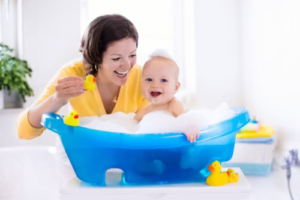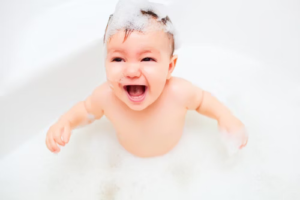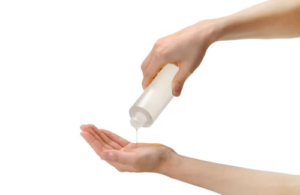As the term “baby skin” suggests, babies’ skin is soft and beautiful, and you may imagine that it does not require special care. However, babies’ skin is actually very delicate. Babies’ skin has less moisture and sebum than adults, so it is prone to dryness. It is important to consciously moisturize your baby’s skin throughout the year, not just in the dry winter air. Make sure to thoroughly remove sweat and dirt in the bath, and moisturize frequently.

Why babies need skin care
When you think of baby skin, you might think it’s smooth and soft, and doesn’t need any skin care. However, some babies may develop eczema on their face, heat rash, or dry, flaky skin. Some
people may wonder, “Why is this only happening to my child?” or “Isn’t baby skin supposed to be beautiful?” Here are some methods to help you deal with such troublesome infant skin care.
Infant skin is delicate

In fact, babies’ skin is prone to dryness. This is because babies have less moisture and sebum than adult skin, regardless of the season.
Also, drool, tears, milk, etc. may remain on the skin, causing rashes or red spots. When removing dirt, you may scrub too hard and end up irritating the skin. It is necessary to
moisturize the skin, which is already prone to dryness, on a daily basis and keep it clean.
There is also data showing that it suppresses the onset of atopic dermatitis.
According to a study by the National Center for Child Health and Development, babies who were moisturized daily from the time they were newborns had a more than 30% reduced risk of developing atopic dermatitis compared to babies who only moisturized dry areas.
A randomized clinical research intervention trial in the Development Birth Cohort Study found that applying moisturizers from the neonatal period reduced the risk of developing atopic dermatitis by more than 30%.
While this may not be the case for all babies, it never hurts to start a skin care routine early on, so try to find a method that works for your baby’s skin.
There is also data showing that it suppresses the onset of atopic dermatitis.
According to a study by the National Center for Child Health and Development, babies who were moisturized daily from the time they were newborns had a more than 30% reduced risk of developing atopic dermatitis compared to babies who only moisturized dry areas.
A randomized clinical research intervention trial in the Development Birth Cohort Study found that applying moisturizers from the neonatal period reduced the risk of developing atopic dermatitis by more than 30%.
While this may not be the case for all babies, it never hurts to start a skin care routine early on, so try to find a method that works for your baby’s skin.
Baby skin care tips

Now that you understand the importance of skin care for infants, what exactly should you do? When you think of skin care, many people may think of moisturizing, but it is important to first thoroughly remove dirt and sweat. Here are some tips on how to do this.
1. Wash gently with plenty of foam
Babies sweat more than you might think. Saliva and spit-up milk may remain on their skin. Wash your baby’s body properly in the bath to remove dirt and keep them clean.
Use your hands, not sponges or gauze
To avoid irritating the soft skin, lather the soap thoroughly and wash it gently with bare hands. Wash the neck, armpits, small arms and legs, groin, and buttocks in particular carefully, as these are areas where dirt and sweat tend to accumulate.
Body soap that comes out as foam is convenient

Even if you wash your baby with lots of foam, it can be difficult to lather the soap while holding the baby. It’s easier if you use a body soap that foams. If you use solid soap, you can also use a foaming net. There are
many soaps and body soaps on the market that are made for babies. Try to choose one that is as gentle as possible.
Wash from top to bottom. Rinse thoroughly.
If you wash your body before washing your head, dirt and foam from rinsing your hair may remain on your skin. To avoid leaving any residue behind, wash your head, face, body, etc. from top to bottom.
2. Moisturize thoroughly

Once you have thoroughly removed all dirt from your skin, it is time to moisturize. Not only do you need to choose the right moisturizer, but you also need to consider the amount to use, the timing and frequency of moisturizing.
Choose a moisturizer that suits your skin type
There are various types of moisturizers for babies, from lotion to cream to oil. Use the lotion type for normal skin, cream type when dryness is a concern, and combine it with Vaseline as needed, depending on the skin condition. Moisturizers with a good spreadable texture are easy to apply and do not rub into the skin.
Moisturize not only after a bath but whenever you notice it
Be sure to moisturize your baby 2-3 times a day, not only after they get out of the bath, but also after changing clothes and diapers. You can also moisturize your baby whenever you notice that their skin is dry.
Apply moisturizer slowly and generously without rubbing
Apply moisturizer carefully to each part of your body, such as your hands, feet, stomach, back, and buttocks. You may be tempted to apply too much force when trying to thoroughly moisturize your skin, but scrubbing too hard can be too harsh and will defeat the purpose. Apply moisturizer to your skin and gently rub your hands in circular movements. The surface of your skin should feel moist.
Skin care is communication with your baby

Daily care is important to protect your baby’s delicate skin. Be sure to keep it clean and moisturized.
Skin care is also a way to communicate with your baby and mom and dad. Please continue to take care of your skin with the same enthusiasm as you enjoy interacting with your baby.